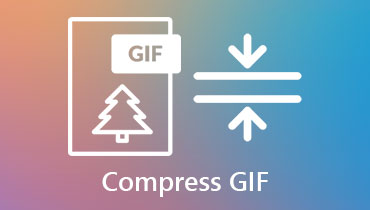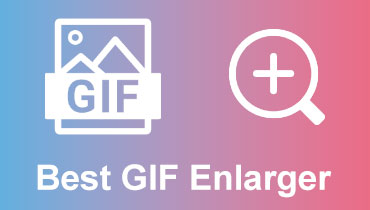How to Colorize GIFs: 3 Ways with Step-by-Step Guides
I'm sure everyone has had this thought while browsing videos or GIFs online: capturing those beautiful, dynamic expressions or silly faces to make GIF stickers.
Yes, you can indeed do that—provided the video footage you're working with is in color. But don't forget, there are still plenty of treasures waiting to be discovered in those archives of black-and-white films. While black-and-white videos don't hinder GIF creation, our eyes accustomed to color often crave a touch of hue—making them appear as vivid as real footage.
By now, this guide's purpose is clear: finding ways to colorize GIFs. We've prepared three methods suitable for users of all skill levels. Detailed instructions and accompanying images ensure you won't get stuck.

PAGE CONTENT
Part 1. Can GIF Be Colorized
You might be skeptical about changing GIF colors—is this really feasible? If so, how exactly would it work?
Let's first explore the feasibility of coloring GIFs.
You may have seen numerous examples of black-and-white films or photos being recolored. Thanks to advancements in AI, this technology is now within reach. There's no need for manual pixel-by-pixel coloring—AI analyzes the brightness and contrast information in each frame to intelligently apply color to the image.
Numerous tools exist for this purpose, available as desktop software or online platforms. We'll recommend two options in the following sections.
If your GIF already has color but suffers from distortion, or if you wish to adjust hue, saturation, filters, or perform precise manual edits, consider industry-leading software like Adobe Premiere Pro. However, this approach can be time-consuming and requires a solid technical foundation in such tools.
Nevertheless, we'll provide a step-by-step guide for your reference.
Part 2. How To Colorize GIF - Best Method
With AI assistance, do you feel the road ahead has become a bit easier?
Then let's briefly outline how to recolor a GIF: First, use an AI-powered coloring tool to add color to your selected video clip. Once you have the colored footage, simply extract the GIF you want.
We've already found the best assistant for you: Vidmore Vidhex.
This tool uses AI technology to automatically colorize videos—simply upload your footage. The system intelligently identifies people, landscapes, and scenes, adding natural color gradients to each frame. Once colorization is complete, you can export the result as a video or further convert it into a GIF animation, making your work more visually impactful.
Key Features
• Automatically colorize black-and-white videos, restoring original tones and ambiance.
• Enhance brightness and clarity with AI to optimize low-light footage.
• Automatically adjust contrast, saturation, and color balance.
• Supports one-click stabilization for smoother footage.
• Directly generates high-quality GIFs from colorized videos.
Here are the steps to colorize black-and-white videos and create GIFs using Vidmore Vidhex:
Step 1. Launch Vidmore Vidhex after installation, and choose the AI Color option on the main interface. Then, click B&W colorization > Start Now.
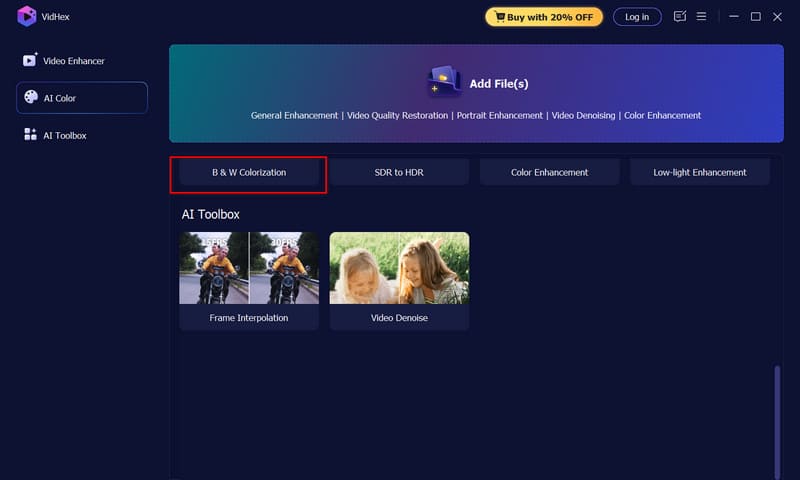
Step 2. Upload your black-and-white video, then pick a preferred color style. The system will automatically apply AI-based colorization and show a real-time preview.
Step 3. Once you’re satisfied with the colored video, click Export All to save it.
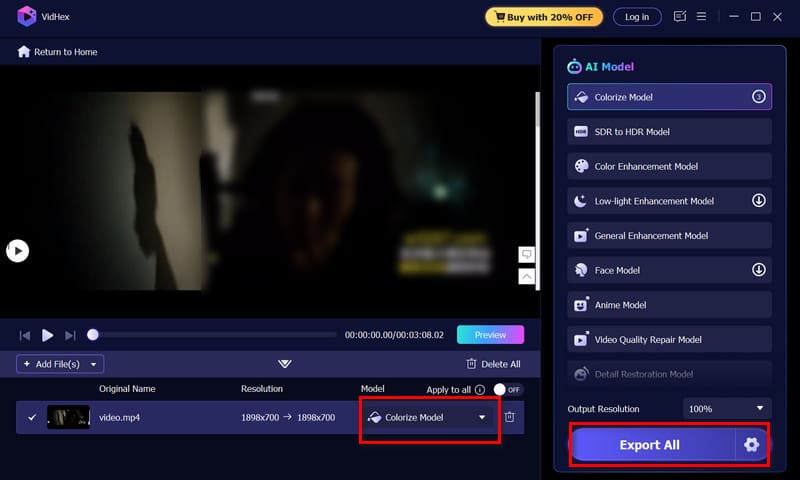
Once you have the colored source video, you can use a professional GIF creation tool like Ezgif to convert MP4 to GIF.
Part 3. How To Change GIF Color With Adobe Premiere Pro
Alright, now you know how to use AI to edit GIF colors.
However, some might feel that relying solely on AI coloring yields unpredictable results, making it hard to ensure the final colors match your ideal vision.
If you prefer to control the entire coloring process and manually adjust GIF hues, you can try using Adobe Premiere Pro.
Considering you might be unsure about the steps, we've prepared the following guide for you:
Step 1. Launch Adobe Premiere Pro and bring your GIF onto the timeline. Press Shift+7 to access the Effects panel. In the search bar, enter Change to Color, then drag the Change to Color effect onto your GIF track.

Step 2. Press Shift+5 to open the Effect Controls panel. Under the Change to Color section, use the From eyedropper to select the color in the GIF that needs to be altered. The chosen color will automatically switch to red as the default.
Step 3. Modify the Tolerance (Hue) and Softness parameters to achieve a more precise color replacement. These settings help isolate the targeted color while keeping the GIF’s original quality intact.
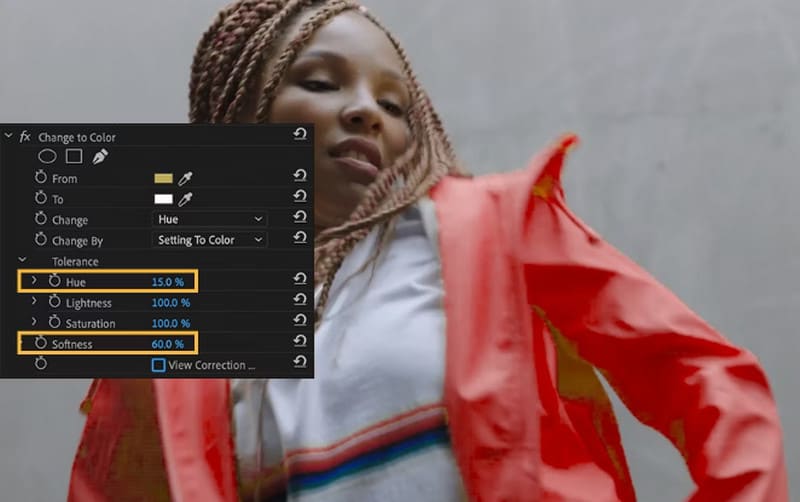
Step 4. Click the To color chip to define your new color choice. With the playhead positioned at the start of the GIF, hit the stopwatch icon next to To to set the initial keyframe for the color animation.
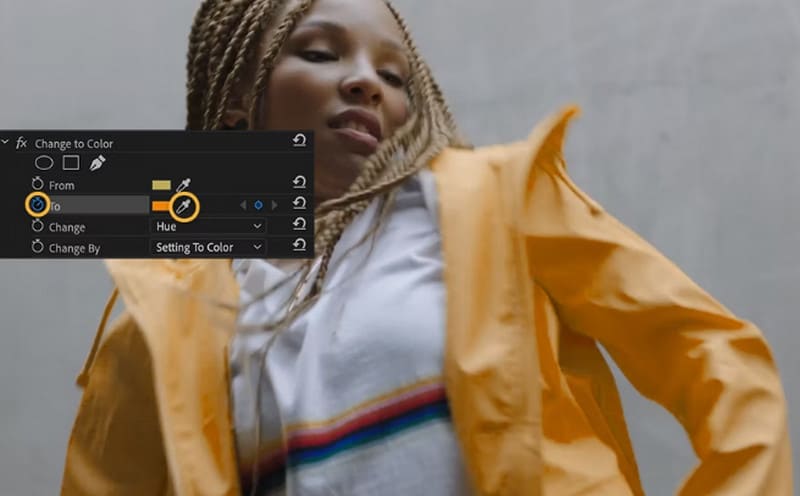
Step 5. Move the playhead forward and select another To color to generate an additional keyframe. Continue progressing through the timeline, adding new colors at different points to create a seamless color transition. Press the spacebar to preview your animated color effect.
Step 6. To add more motion and rhythm, synchronize the color transitions with the beat of a song or any rhythmic element in your video, giving your GIF a lively and creative visual flow.
Part 4. How To Recolor GIF Online
I just want to easily create a color GIF without downloading or installing software, and without making things overly complicated. If that's the case, Kapwing—an online platform that supports these operations—might be exactly what you need.
Among its many built-in tools is a Color Corrector that allows you to change the colors in videos and GIFs.
Now let's see how to use Kapwing to change colors and add filters to GIFs:
Step 1. Head to kapwing.com and select Start Editing to launch Kapwing Studio. Import your GIF by choosing Upload or simply dragging the file into the workspace.
Step 2. After your GIF appears in the editor, click on it to highlight the layer. From the right-side toolbar, select Adjust to reveal various color options. Use the Hue slider to shift the overall tone of your GIF, moving it left or right until you find a color scheme that fits your style.
Step 3. To refine your results, tweak additional parameters like Brightness, Contrast, and Saturation. These adjustments help you balance the visual tone and enhance the overall aesthetic of your GIF.
Step 4. When the color adjustments meet your expectations, press Play to preview the animation. Finally, click Export in the upper-right corner and choose Export as GIF. Once processing finishes, download the updated, color-enhanced GIF to your computer.
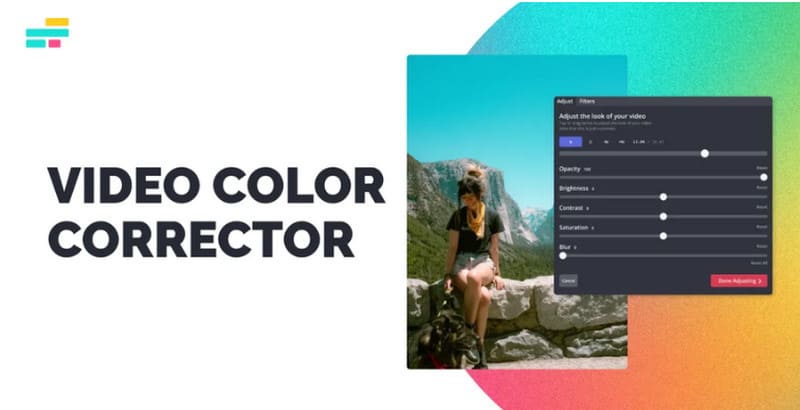
Part 5. FAQ of Colorize GIF
Can I edit an animated gif?
Sure. You can use various online or desktop tools like EZGIF to edit GIFs. You can trim them, adjust frame rates, add text, stickers, or special effects, and more.
Can you change the color of a GIF?
Of course. Many GIF editors support adjusting hue, brightness, contrast, or saturation. For more precise coloring, you can first colorize the video and then convert it to a GIF to achieve more natural color effects. We recommend trying tools like Vidmore VidHex.
Does Adobe have a GIF editor?
Yes. Both Adobe Photoshop and Adobe Premiere Pro can do this. Photoshop is suitable for frame-by-frame adjustments, while Premiere Pro is better for coloring and applying special effects to source video footage before exporting the GIF.
Conclusion
By now, you should fully understand that colorizing GIFs is entirely feasible.
If you prefer a hands-off approach with one-click coloring, AI-powered software like Vidmore VidHex is ideal.
For those who want to control the details and coloring process themselves, Adobe Premiere Pro is the way to go.
And if you just need a quick, simple way to produce colored GIFs, online platforms like Kapwing are the most suitable option.

